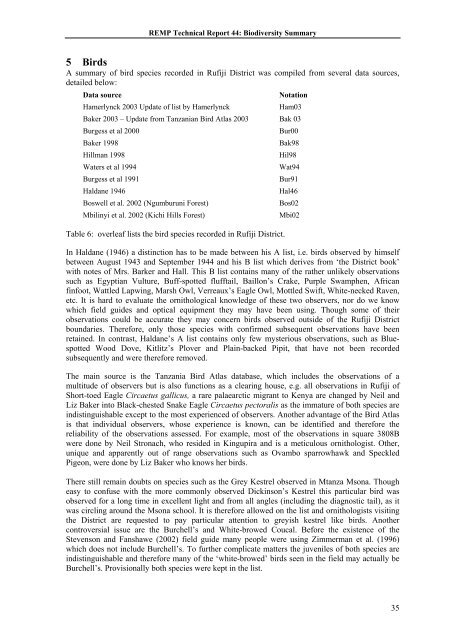Family / Scientific name - Coastal Forests of Kenya and Tanzania
Family / Scientific name - Coastal Forests of Kenya and Tanzania
Family / Scientific name - Coastal Forests of Kenya and Tanzania
You also want an ePaper? Increase the reach of your titles
YUMPU automatically turns print PDFs into web optimized ePapers that Google loves.
REMP Technical Report 44: Biodiversity Summary<br />
5 Birds<br />
A summary <strong>of</strong> bird species recorded in Rufiji District was compiled from several data sources,<br />
detailed below:<br />
Data source Notation<br />
Hamerlynck 2003 Update <strong>of</strong> list by Hamerlynck Ham03<br />
Baker 2003 – Update from <strong>Tanzania</strong>n Bird Atlas 2003 Bak 03<br />
Burgess et al 2000 Bur00<br />
Baker 1998 Bak98<br />
Hillman 1998 Hil98<br />
Waters et al 1994 Wat94<br />
Burgess et al 1991 Bur91<br />
Haldane 1946 Hal46<br />
Boswell et al. 2002 (Ngumburuni Forest) Bos02<br />
Mbilinyi et al. 2002 (Kichi Hills Forest) Mbi02<br />
Table 6: overleaf lists the bird species recorded in Rufiji District.<br />
In Haldane (1946) a distinction has to be made between his A list, i.e. birds observed by himself<br />
between August 1943 <strong>and</strong> September 1944 <strong>and</strong> his B list which derives from ‘the District book’<br />
with notes <strong>of</strong> Mrs. Barker <strong>and</strong> Hall. This B list contains many <strong>of</strong> the rather unlikely observations<br />
such as Egyptian Vulture, Buff-spotted flufftail, Baillon’s Crake, Purple Swamphen, African<br />
finfoot, Wattled Lapwing, Marsh Owl, Verreaux’s Eagle Owl, Mottled Swift, White-necked Raven,<br />
etc. It is hard to evaluate the ornithological knowledge <strong>of</strong> these two observers, nor do we know<br />
which field guides <strong>and</strong> optical equipment they may have been using. Though some <strong>of</strong> their<br />
observations could be accurate they may concern birds observed outside <strong>of</strong> the Rufiji District<br />
boundaries. Therefore, only those species with confirmed subsequent observations have been<br />
retained. In contrast, Haldane’s A list contains only few mysterious observations, such as Bluespotted<br />
Wood Dove, Kitlitz’s Plover <strong>and</strong> Plain-backed Pipit, that have not been recorded<br />
subsequently <strong>and</strong> were therefore removed.<br />
The main source is the <strong>Tanzania</strong> Bird Atlas database, which includes the observations <strong>of</strong> a<br />
multitude <strong>of</strong> observers but is also functions as a clearing house, e.g. all observations in Rufiji <strong>of</strong><br />
Short-toed Eagle Circaetus gallicus, a rare palaearctic migrant to <strong>Kenya</strong> are changed by Neil <strong>and</strong><br />
Liz Baker into Black-chested Snake Eagle Circaetus pectoralis as the immature <strong>of</strong> both species are<br />
indistinguishable except to the most experienced <strong>of</strong> observers. Another advantage <strong>of</strong> the Bird Atlas<br />
is that individual observers, whose experience is known, can be identified <strong>and</strong> therefore the<br />
reliability <strong>of</strong> the observations assessed. For example, most <strong>of</strong> the observations in square 3808B<br />
were done by Neil Stronach, who resided in Kingupira <strong>and</strong> is a meticulous ornithologist. Other,<br />
unique <strong>and</strong> apparently out <strong>of</strong> range observations such as Ovambo sparrowhawk <strong>and</strong> Speckled<br />
Pigeon, were done by Liz Baker who knows her birds.<br />
There still remain doubts on species such as the Grey Kestrel observed in Mtanza Msona. Though<br />
easy to confuse with the more commonly observed Dickinson’s Kestrel this particular bird was<br />
observed for a long time in excellent light <strong>and</strong> from all angles (including the diagnostic tail), as it<br />
was circling around the Msona school. It is therefore allowed on the list <strong>and</strong> ornithologists visiting<br />
the District are requested to pay particular attention to greyish kestrel like birds. Another<br />
controversial issue are the Burchell’s <strong>and</strong> White-browed Coucal. Before the existence <strong>of</strong> the<br />
Stevenson <strong>and</strong> Fanshawe (2002) field guide many people were using Zimmerman et al. (1996)<br />
which does not include Burchell’s. To further complicate matters the juveniles <strong>of</strong> both species are<br />
indistinguishable <strong>and</strong> therefore many <strong>of</strong> the ‘white-browed’ birds seen in the field may actually be<br />
Burchell’s. Provisionally both species were kept in the list.<br />
35

















